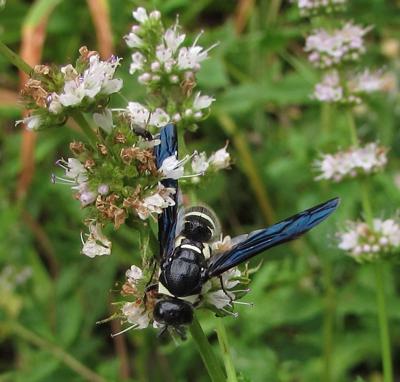©Marlene A. Condon
June 1, 2019

Wasps, such as this mason wasp feeding at mint flowers in the author’s garden, are valuable pollinators. In return for helping plants to reproduce and thus perpetuate their species, the wasp is rewarded with food. Courtesy of Marlene Condon
A United Nations report published on May 6 tells us “about one-third of all species right now in the U.S. are at heightened risk of potential extinction in the next couple of decades.” All of us can help to prevent this situation from happening.
Many of these animals come through our yards during migration (birds) and some could be living there now (frogs and salamanders), if you’ve already landscaped with wildlife in mind. If you haven’t done that yet, don’t worry as I hope to provide tips to make your yard or balcony more welcoming to the critters we should make feel at home around us.
I’ll be sharing the knowledge I’ve gained from closely observing the natural world throughout my life. I’ve been extremely interested in learning about wildlife and wildflowers for as long as I can remember, and have documented my discoveries in print and photographs. By reading this column, I hope you will gain a new understanding of how the natural world works, and I hope, come to value and love it as much as I do.
Our wildlife keeps the environment functioning properly for our benefit, which means your yard and gardens will be much more productive with its help. For example, gardeners think highly of earthworms because they burrow through the soil, which provides aeration (the creation of spaces where plant roots can grow and receive air and water from the surface). But other organisms, such as ants, also perform this job and are equally important to the health of your plants.
You may think of ants as “pests” because we don’t want them inside our homes, but there are steps you can take to prevent that from happening. Another aspect of this column will aim to explain how you can peacefully coexist with our wildlife, such as caulking cracks to deter the entry of ants and other insects and not placing mulch close to the foundation of your house and other structures.
By placing plants a few feet away from buildings instead of very close to them, as is often done, you allow them access to sunlight and rain, and you keep animals attracted to the plants farther away. This limits the opportunity for them to find a way into your residence, especially if they find mulch around the plants a good place to live.
It’s important to recognize the value of organisms to the environment and to learn to coexist with them. It may not always be easy or what you prefer, but we really have no choice if we want the Earth to be healthy and to support us.
Marlene A. Condon is the author/photographer of “The Nature-friendly Garden: Creating a Backyard Haven for Plants, Wildlife, and People.” You can reach her at marlenecondon@aol.com and find info on marlenecondon.com
